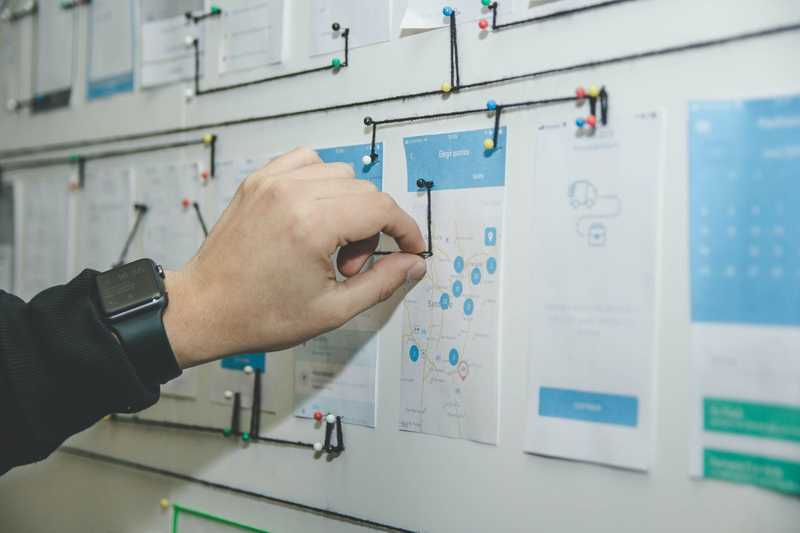User research is essential for any business aiming to improve its products, services, and marketing strategies. It helps you understand your audience's needs, preferences, and pain points, enabling you to make informed decisions that enhance user satisfaction.
This article will guide you through the steps of conducting effective user research, ensuring you gather valuable data to drive your business forward.
What is User Research?
User research involves collecting data to understand your target audience better. It sheds light on their behaviors, desires, and requirements, allowing you to tailor your offerings for maximum impact. Common user research methods include:
- User interviews
- Surveys and questionnaires
- Focus groups
- Usability testing
Regardless of your preferred choice, the main goal is to understand how the users interact with your product or service. Each method aims to provide insights into how users interact with your products or services, guiding your decisions in design, development, and refinement.
Furthermore, this data can be used to uncover underlying problems and identify pain points. With all the required information on your hand, you can make better decisions.
Photo by UX Indonesia on Unsplash
Types of User Research
After discovering the use of user research, the next step is to learn about the different types available. While choosing the right type is based on personal needs and preferences, it’s important to understand what they consist of to make the right decision for your unique circumstances.
That being said, the main types of user research you should know of are the following:
- Qualitative research
- Quantitative research
- Mixed methods
Qualitative research
The first type we’ll elaborate on is qualitative research. This process uses non-numerical data to gather in-depth insights about the user experience. It’s usually conducted in small groups with detailed questions related to the product or service. As such, qualitative research often utilizes observation methods and focus groups to achieve the desired results.
This type of research is best used for gathering information about customer behavior and market trends while focusing on user motivation and needs. Given that this method relies on analyzing non-numerical information, focusing on accuracy and reliability is crucial.
If you’re having trouble during your research, remember that the latest technological advancements offer various tools designed to help collect and analyze qualitative data. For instance, our User Evaluation platform enables you to transcribe and organize all your research in one place, while also extracting key insights automatically.
Quantitative research
The second type of user research you should know of is quantitative research. In contrast to qualitative research, quantitative research involves gathering and analyzing numerical data. Thus, its main goal is to identify relationships among variables, trends, and patterns.
To successfully gather the needed data, quantitative research requires testing large groups of users. For that reason, the most effective techniques are surveys, questionnaires, and experiments. Once the gathered information has gone through statistical analysis, you can use these insights to understand the population at large.
The reason why many people prefer this option is because it can deal with complex phenomena and highlight hidden factors that may be missed during qualitative studies. Furthermore, they allow you to compare results with different contexts, leading to more rigorous testing. By crafting more specific questions surrounding the topic, quantitative research can be used in various fields, including healthcare, marketing, and economics.
Similar to qualitative research, you can make use of numerous tools to make this process less straining. With the latest technological advancements, you can now use machine learning, automatic surveys, and advanced analytics to your advantage.
Mixed methods
To ensure you get the most out of your user research process, you can also incorporate mixed methods into your strategy. This involves combining both qualitative and quantitative user research techniques to achieve in-depth and precise results.
While many businesses believe that they should only collect qualitative data and validate it with quantitative findings, there are numerous variations you can try out. These mixed research methods add more credibility to your insights and aid in generalizing the larger population. However, they’re well-known for their complexity and time-consuming nature.
Photo by Scott Graham on Unsplash
How to Conduct User Research Step-by-step
Now that you’re well-informed about the basics of user research, the next step is planning out the process. While each business may have its unique approach to research, there are several steps you should follow to make the most out of it. Thus, conducting effective user research requires the following steps to deliver the best results:
- Defining goals and objectives
- Choosing research methods
- Preparing research materials
- Recruiting the right participants
- Conducting the research
- Analyzing the gathered data
- Sharing insights
Defining goals and objectivesDefining your business goals and research objectives is crucial before you begin any research, development, or marketing process. It enables you to identify the most relevant information and find optimal solutions for addressing knowledge gaps.
When defining your objectives, you can follow the SMART framework. This stands for:
- Specific: all research objectives should be precise and focused instead of broad
- Measurable: to be able to draw conclusions, your findings must be quantifiable or verifiable.
- Attainable: although your goals may be ambitious, ensure they are realistic.
- Relevant: the whole research process can be for nothing if the findings are irrelevant. Thus, you should always strive for important and meaningful objectives.
- Time-bound: all your research goals should have a specific timeframe in which they are conducted. This allows you to better plan your resources, time, and limitations.
Choosing research methods
The second step in conducting effective user research is choosing the appropriate user research methods. While opting for the seemingly simpler option might be tempting, remember that your choice should align with the specific information you seek. You should also align the user research techniques with the predefined goals and objectives to reach a desirable outcome.
For example, if you’re planning on basing your research on qualitative data, then you should focus your attention on crafting user interviews. On the other hand, if you’re interested in gathering quantitative data, you can use focus groups for a larger audience and surveys and questionnaires for a smaller one.
Regardless of whether you opt for qualitative or quantitative research, always prepare an appropriate testing plan specific to your chosen method. Remember that conducting effective interviews is highly dependent on the questions you ask the participants and the direction you guide them in.
Preparing research materials
Once you have chosen the appropriate research methods for your circumstances, you should begin preparing appropriate research materials. When creating these tests, remember that the main goal is to collect information about your product or service. Thus, you should include questions that represent your research goals and objectives.
Whether you're conducting usability test scenarios, user interviews, or surveys, ensure that the questions within each method are open-ended. Doing so will allow the users to give an in-depth answer and point out key points which you may otherwise miss. Additionally, ensure that the questions are clear, precise, and simple to ensure participants understand what is being asked of them.
When conducting user testing, remember to include the scenarios that have the most value. For example, they should accurately reflect the actions most commonly completed when users interact with the product or service.
Recruiting the right participants
Once you’ve chosen the appropriate research methods based on your goals and objectives, you can then start recruiting the right participants. While many businesses often overlook the importance of this step, choosing the appropriate users for testing will have a big impact on your user research.
To ensure you get the results you’re looking for, you should focus on finding participants closely related to your target audience and user personas. You can do so through email marketing, social media, online tools, and even word-of-mouth.
During the recruiting process, it’s important to provide users with information about the entire testing process. It’s recommended to include the duration of the research, the benefits or payment they should expect, as well as any instructions that will improve their performance during the test.
Conducting the research
After you’ve prepared the candidates and tests, the next step is to conduct the research itself. First, you should set the appropriate time or deadline for the testing. When conducting user interviews, you should schedule a call within a limited timeframe. As for surveys and questionnaires, they should include a deadline before which the participants are supposed to send in their results.
Next, remember that observation in user research is essential for gathering insightful data. During usability testing, ensure you pay close attention to how the participants interact with your product or service and note any important aspects. If you’ve chosen user interviews, make sure you prompt the users to give you elaborate answers and note their responses.
Lastly, be mindful of the participant’s time and effort by adhering to the given timeframe and providing clear instructions.
Analyzing the gathered data is the most complicated and time-consuming step in the user research process. Only when you’ve thoroughly analyzed the data can you efficiently recognize trends and paint points that you can then use to optimize your product. While reviewing and organizing all the gathered information manually may sound impossible, numerous online tools can help you in the process.
For example, if you’re looking to analyze your qualitative data, the already mentioned User Evaluation platform allows you to transcribe your content and generate insights with the help of AI technology. Furthermore, it offers various insights templates, AI tags, clips, and collections to keep your workplace organized. Whenever you may feel stuck during a certain data-interpretation, you can ask the intelligent AI chat to decipher the meaning behind the findings.
On the other hand, quantitative data may require statistical software to interpret the gathered information. During the analysis, look for patterns and areas of improvement that you can then leverage to enhance the usability of your product and service.
Sharing insights
The last step in the user research process is sharing the gathered insights and research findings. After completing the data analysis, many businesses expect you to craft a presentation or report to share with your team. Doing so allows the whole company to keep track of the latest developments and find suitable solutions to the problems addressed.
If you struggle to condense large volumes of data into a concise statement, you can once again rely on User Evaluation’s advanced technology to create AI reports and presentations. Besides the AI-curated insights, you can also include data visualizations to help your teammates easily understand the findings.
Photo by Alvaro Reyes on Unsplash
Importance and Benefits of Effective User Research
As mentioned, effective user research is an important aspect of any successful business and can lead to numerous potential benefits. If you're still contemplating whether it's worth your time and effort, here are some of its advantages:
- Customer-centric design
- Improved product usability
- Enhanced user satisfaction
- Increased customer loyalty
Customer-centric design
The first benefit from effective user research is creating a customer-centric design. By understanding how the users interact with your product or service, you can tailor the design to their wants and needs. Not only will this lead to improved product usability, but it’ll also enhance user satisfaction.
Improved product usability
Addressing all the pain points and areas of improvement will also lead to improved product usability. It’s only natural that you may start losing customers if your product or service doesn’t align with what the audience is looking for, as even the smallest detail can cause a significant inconvenience for users. Thus, it’s best to discover and fix the frequent issues that the users are coming across to ensure the product or service is optimized for use.
Enhanced user satisfaction
Since your products and services will be optimized for the customers, effective user research also leads to enhanced user satisfaction. This term is generally used to describe the customer’s experience with your product or service. A higher user satisfaction means that the users are comfortable using your product and that it meets their expectations.
Increased customer loyalty
The customer-centric design, improved product usability, and enhanced user satisfaction all lead to increased customer loyalty. Every business strives to build a loyal fanbase around its product or service since it directly affects the company’s success. Gaining the audience’s trust will lead to returning customers who are also willing to promote your product to others.
Conclusion
After discovering how to conduct effective user research, we recommend you follow the steps mentioned in the article to make the most out of the process. While it may sound overwhelming if you don’t have any prior experience, remember that practice makes it perfect. Furthermore, you can always use online tools such as User Evaluation to aid in the process and help save you time.
So take the time to plan out your research goals, choose the suitable user research methods, prepare the materials carefully, and find the appropriate participants before you begin testing. Remember to stay observant during the testing and take notes of all important aspects. Once you’re done, thoroughly analyze your data and share the findings with your team.
And voila! You’ve successfully completed effective user research and are well on your way to improving your product or service.



